Guidelines for Visual Meteor Observers
August 2025
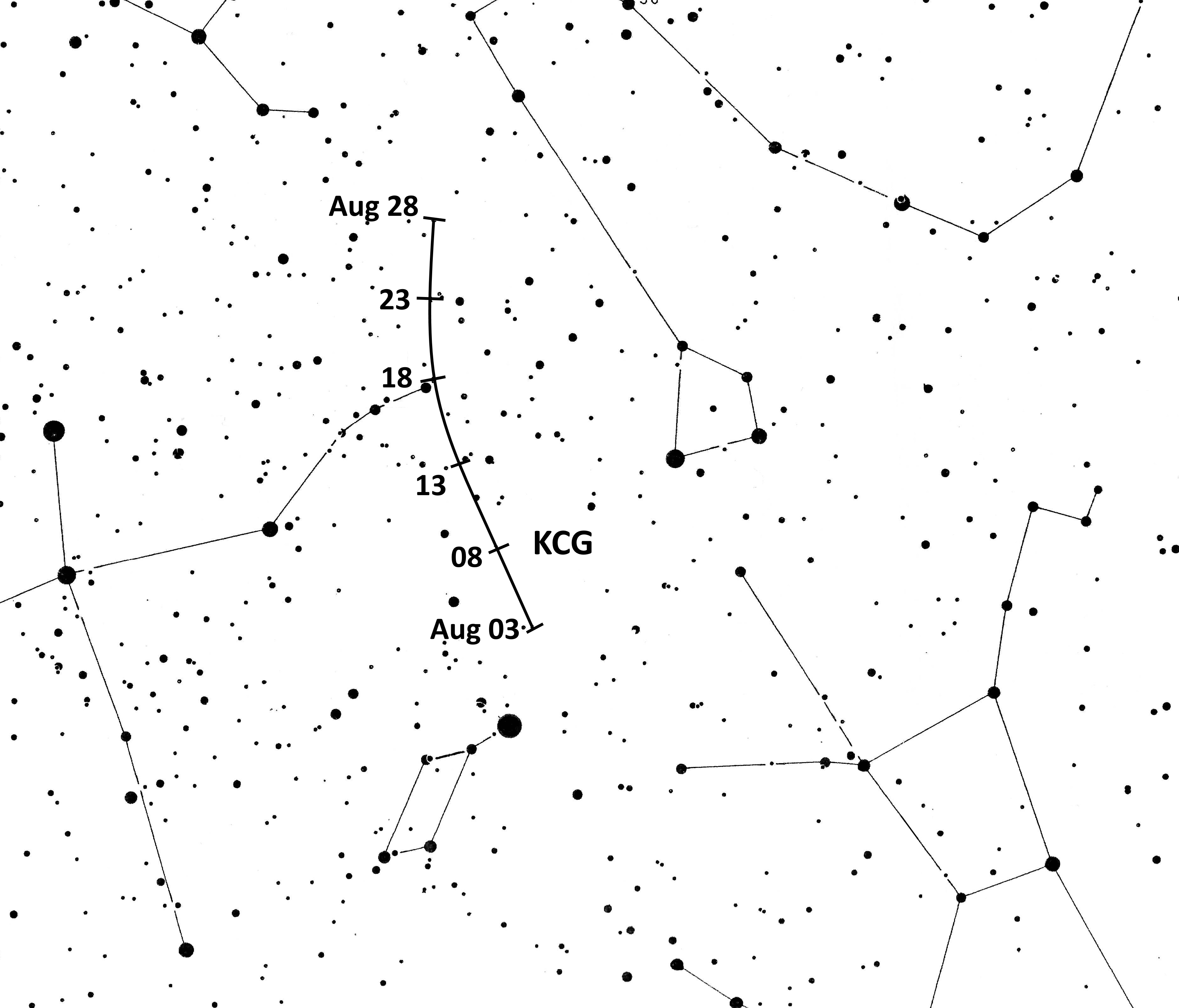
After the maxima of the Southern Delta Aquariids and Alpha Capricornids were still well observable at the end of July, the observing conditions deteriorate due to the increasing moon phase. From mid-month, the nights are longer usable for observations without moon interference.
The stream of the month, the Perseids, reaches its maximum this year on August 12. This corresponds to about the time for the maximum at a solar longitude of approximately 140 degrees. At the beginning of the night, the radiant in the constellation Perseus already reaches a height of around 30 degrees above the horizon. The optimal height is reached during the second half of the night. Due to the waning moon three days after full moon, observations are restricted, and the number of visible meteors is greatly reduced. Besides the main maximum, in recent years, one to two days later, individual secondary maxima occurred. Therefore, the nights before and after the maximum should also be included in the planning of observations.
The Kappa Cygnids reach their maximum on August 16. The radiant is above the horizon all night. At the maximum, the rates are about three meteors per hour, which can be well tracked without moon interference. In the available video data, a clear maximum is seen at solar longitude 144 degrees (corresponds to August 16). The activity is clearly detectable from August 2 to early September. Remarkably slow meteors are observed; brighter appearances are also to be expected.
The small stream of the Eta Eridanids begins its activity on July 31 and can be observed until August 19, with the maximum reached on August 7. Due to the waxing moon, observations after the maximum are only possible to a limited extent. Meteors of this stream are best observed in the second half of the night.
July 2025
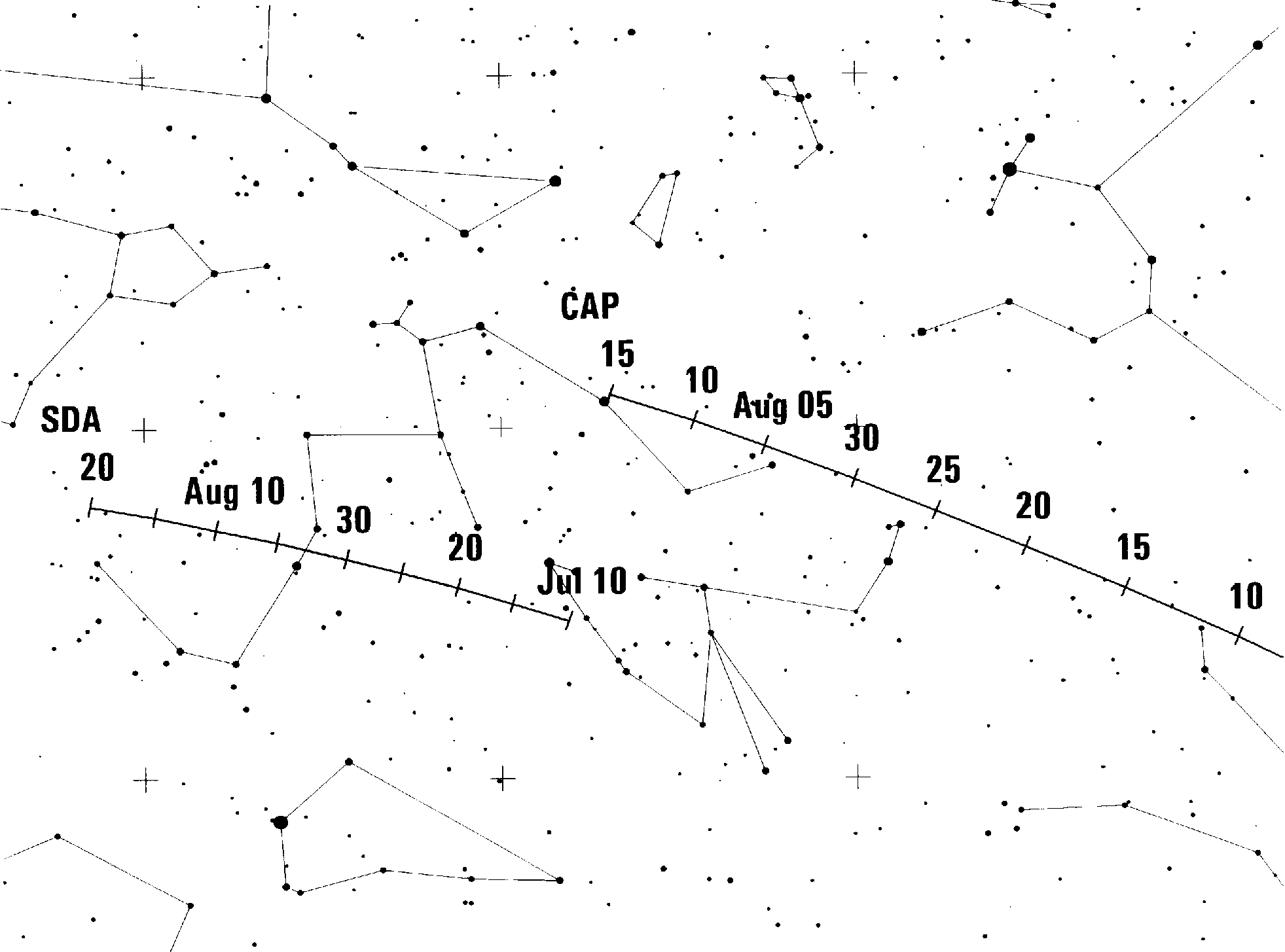
The summer month of July offers numerous opportunities for observing some interesting meteor showers as the nights slowly begin to lengthen again. Observations should preferably be made from around July 15 onwards. At the beginning of the month, observations are possible in the second part of the night without major restrictions due to the waxing moon.
The first meteor shower of the month, the Alpha Capricornids, starts its activity on July 3. This shower can be observed until beyond the end of the month and reaches its peak on July 31. The slow meteors are clearly different from other showers in this period, with brighter appearances also possible. Conditions for observation towards the end of the month are optimal (new moon on July 24).
The July Pegasids are observable from July 4 to 14. The peak occurs on July 10. The radiant is then located at a right ascension of 347 degrees and a declination of +11 degrees. Unfortunately, the observations are severely affected by moonlight. For observers in mid-northern latitudes, the radiant is above the horizon throughout the night. Under favorable conditions, the rates can reach up to five meteors per hour.
The Southern Delta Aquariids, named after the constellation Aquarius, are active from July 12 and peak on July 31. This shower has a significantly higher geocentric speed and therefore differs clearly from the Alpha Capricornids. This year, the observation of the peak of both showers is possible without restrictions due to the new moon on July 24.
The July Gamma Draconids are active from July 25 to 31. At the peak, the radiant is positioned at a right ascension of 280 degrees and a declination of +51 degrees. This position will be reached this year on July 28 around 09:00 CEST. In the observed period from 2017 to 2022, no higher activity was noted; nevertheless, data from this meteor shower is still of interest. Video data shows clearly that the shower occurs annually and has a short variable peak. The meteors have a low geocentric speed. Rates of about five meteors per hour are expected.
From mid-month, the first shooting stars of the Perseids can already be observed. Until the end of the month and beyond, the observation conditions for this most famous meteor shower improve.
June 2025
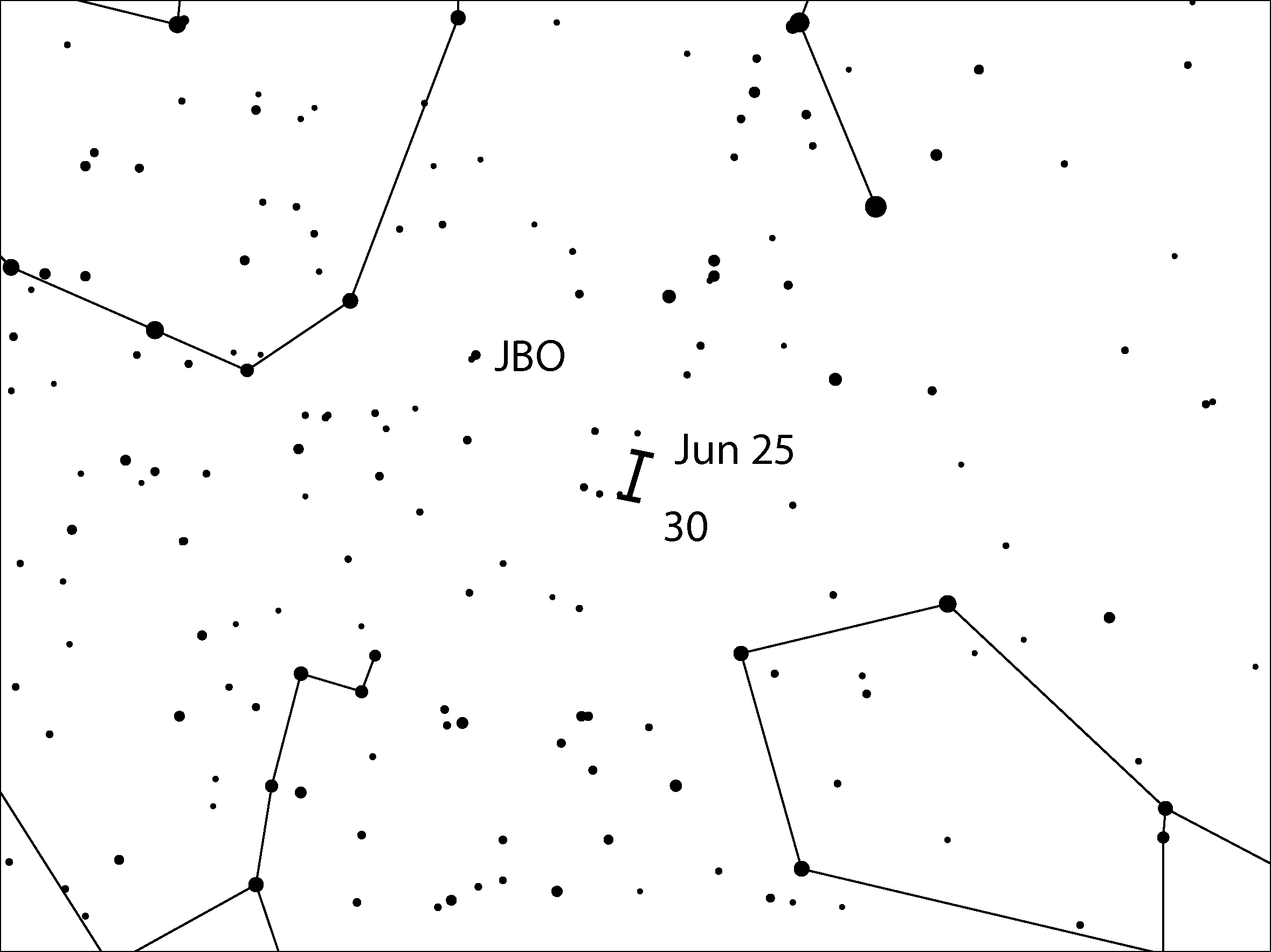
At the beginning of the month, activity starts at a low level. The visible meteors remain only slightly above the sporadic background. There is only a short time window for observations in this summer month.
The few hours in the short June nights are limited at the beginning of the month to the low activity mainly from the region in the ecliptic area of the Anthelion source. In the second half of the month, the June Bootids can be observed without restrictions.
From the beginning of the month until June 24, another interesting meteor shower is active, though the indicated period remains uncertain. The Daytime Arietids reach their maximum on June 7, but the radiant will stand just above the horizon when twilight sets in. Possible observations are very restricted by the waxing moon. Although the data from recent years shows recognizable activity during the above period, there is no clear activity profile as with other meteor showers.
The June Bootids, which reach their maximum on June 27 around 1 PM local time, are well observable. The radiant is circumpolar the entire night. However, due to twilight, the usable period is shortened. With the waning moon (new moon on June 25), optimal conditions are then given. The low entry speed of the particles creates very slow meteors. In the years 1998 and 2004, hourly ZHRs of up to 100 meteors per hour were recorded for a short time. Before that, there were earlier outbreaks in the years 1916, 1921, and 1927 that are well documented. Therefore, one should collect data during streams with short periods of activity throughout the entire active period, provided that the observation conditions allow.
May 2025
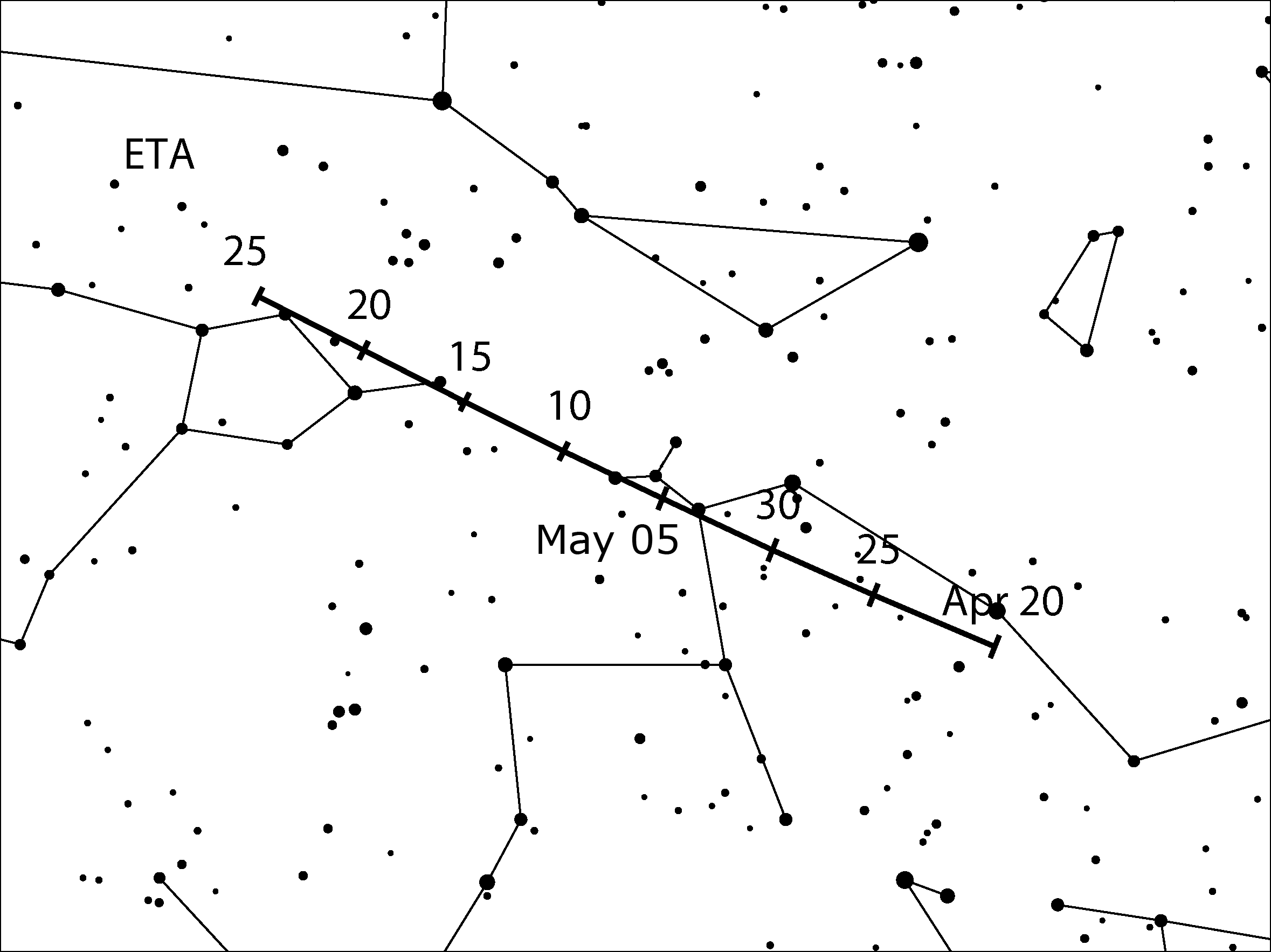
In early May, the Eta Aquariids meteor shower is already active. It reaches its peak on May 6 around 5:00 AM local time. It can only be observed in the morning hours. The radiant rises around 3:00 AM local time. The time window is limited to only one hour under optimal conditions. At the peak, the ZHR ranges between 40 and 65 meteors. However, this only applies to lower latitudes up to 40 degrees north and under optimal conditions, which are not affected by the waxing moon in the morning. Visual data from 1984 onwards show an average ZHR of 30 meteors from May 3 to May 10. In our latitudes, under optimal conditions, at most four to eight Eta Aquariids meteors can be observed during the peak period.
The Eta Lyrids are active from May 5 to May 14. This year, the unfavorable moon phase with a full moon on May 12 hampers potential observations. Visual data from past years, from 2007 to 2021, indicated a medium ZHR of 3 to 4 meteors per hour at the peak on May 10.
The Anthelion source complex, with rates between two and four meteors per hour, remains active. In May, there are only slight variations in activity, with the radiant shifting to the area of the constellation Scorpius.
April 2025
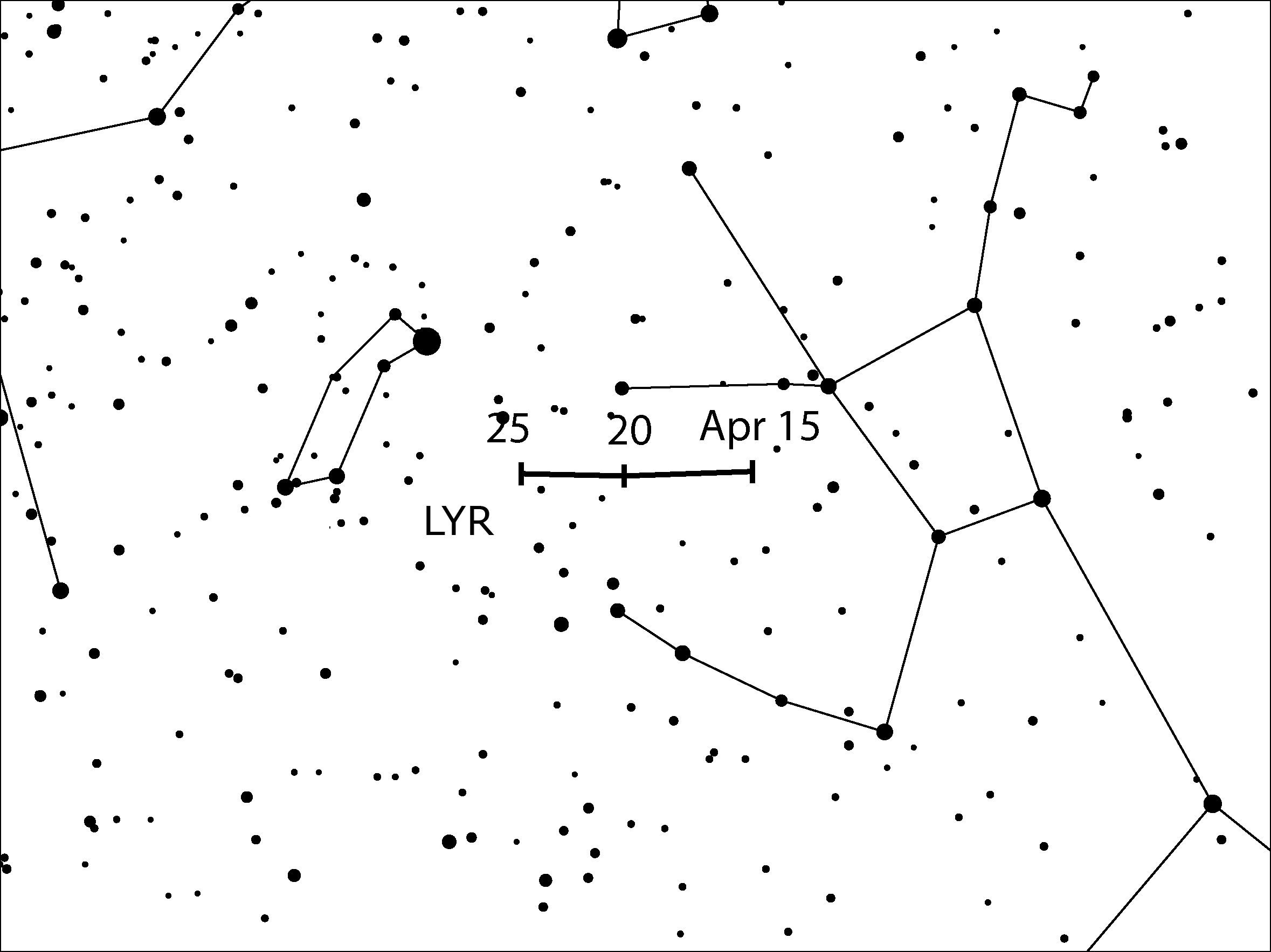
In the month of April, the activity of known meteor showers slowly begins to rise again after a pause of several months.
The Lyrids reach their peak around 3:30 PM local time on April 22. Under optimal conditions, possible ZHRs are around 18 meteors per hour; its radiant reaches a favorable position from around 10:30 PM local time. The waning moon (last quarter on April 21) should not overly interfere with possible observations. Due to the long orbital period of the parent body C/1861 G1 (Thatcher), enough particles are distributed along the orbit. The stream reaches us with relatively constant activity; higher rates occur only for a few hours. In 1982, a ZHR of 90 was even recorded.
In 2014, a new meteor stream was detected in the constellation of Capricornus (Latin: Capricornus). Japanese observers created a first report. This year, potential activity of the April Alpha Capricornids is expected on April 7 around 2:00 PM local time. The position of the radiant is at alpha=304° delta=-13°. Due to the high geocentric velocity, fast meteors could be registered. As closer data are still uncertain, observations on this date are welcome.
In addition, with hourly rates of two to four meteors per hour, the Anthelion source in the sky is only slightly more noticeable compared to the sporadic background. By the end of the month, the radiant shifts from the constellation of Virgo to the constellation of Libra.
From April 19, meteors of the Eta Aquariids can be observed, which are active until about mid-May. The low height of the radiant above the horizon in Central Europe makes southern latitudes up to about 45° N more suitable for observations. North of this, there is a time window of about an hour before dawn to register some stream meteors under optimal conditions. The radiant culminates only around 8:00 AM local time.
March 2025
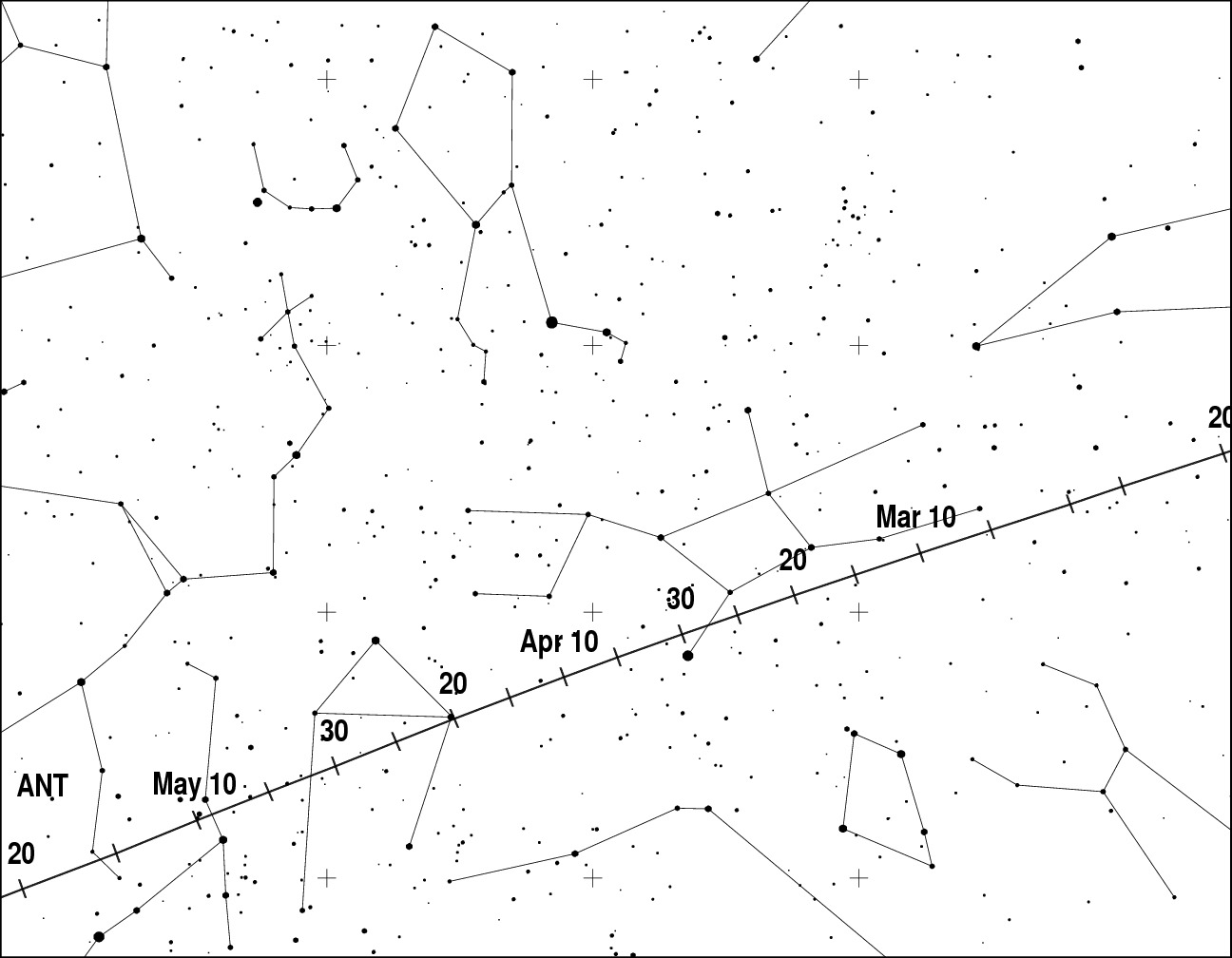
In the month of March, the low rates continue to accompany us. In addition to sporadic meteors, predominantly meteors of the ecliptic complex of the Anthelion source can be observed. At the beginning of the month, the new moon offers optimal conditions for possible sightings, and after mid-month, conditions improve due to the waning moon, allowing for good tracking of the low rates of two to three meteors per hour.
The radiant is an extended area in the ecliptic plane that is located below the constellation Leo at the beginning of the month. This area moves through the constellation Virgo over the course of the month.
However, following any potential higher rates during times of low meteor activity is worthwhile for comparison with observations from other observers and for further analyses.
Over the course of the night, the number of visible meteors increases until the early morning hours. Therefore, one should always focus on the second half of the night during times of lower rates, because observations during the evening hours in February and March yield little due to the lower number of visible shooting stars.
February 2025
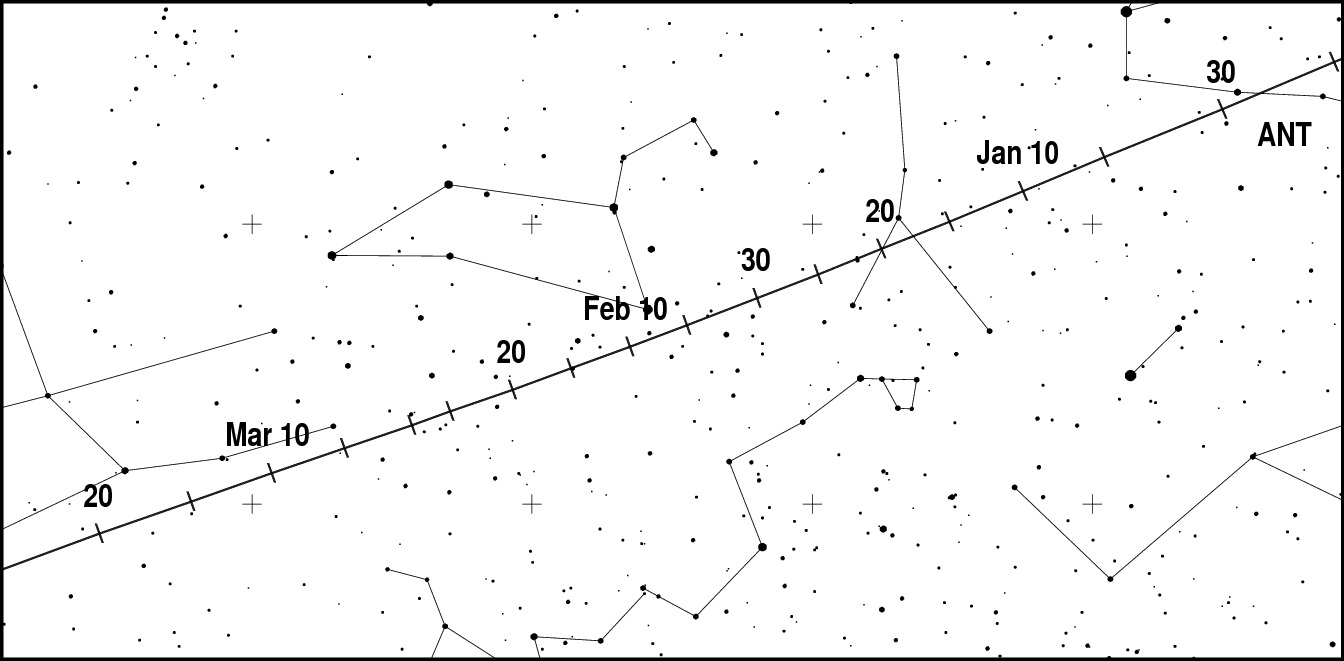
After the Quadrantids provided the first high rates in the previous month, this month follows with low rates of meteors, mainly sporadic in nature. For observing the low activity, the second half of the month is suitable this year.
At the beginning of the month, the Comae-Berenicids can be observed until February 4th, with this stream already active since the beginning of December last year. The rates are around three meteors per hour.
The Anthelion source, which determines the month, shows a diffuse area of about 30 degrees along the ecliptic and around 20 degrees in the vertical as the apparent radiant point for the meteors. The center of this radiant shifts to the southern part of the constellation Leo over the course of the month.
Despite the low rates of sporadic meteors, February shows a clear diurnal variation. While rates of less than five meteors per hour are recorded in the evening, more than ten meteors per hour can occasionally occur in the early morning hours.
January 2025
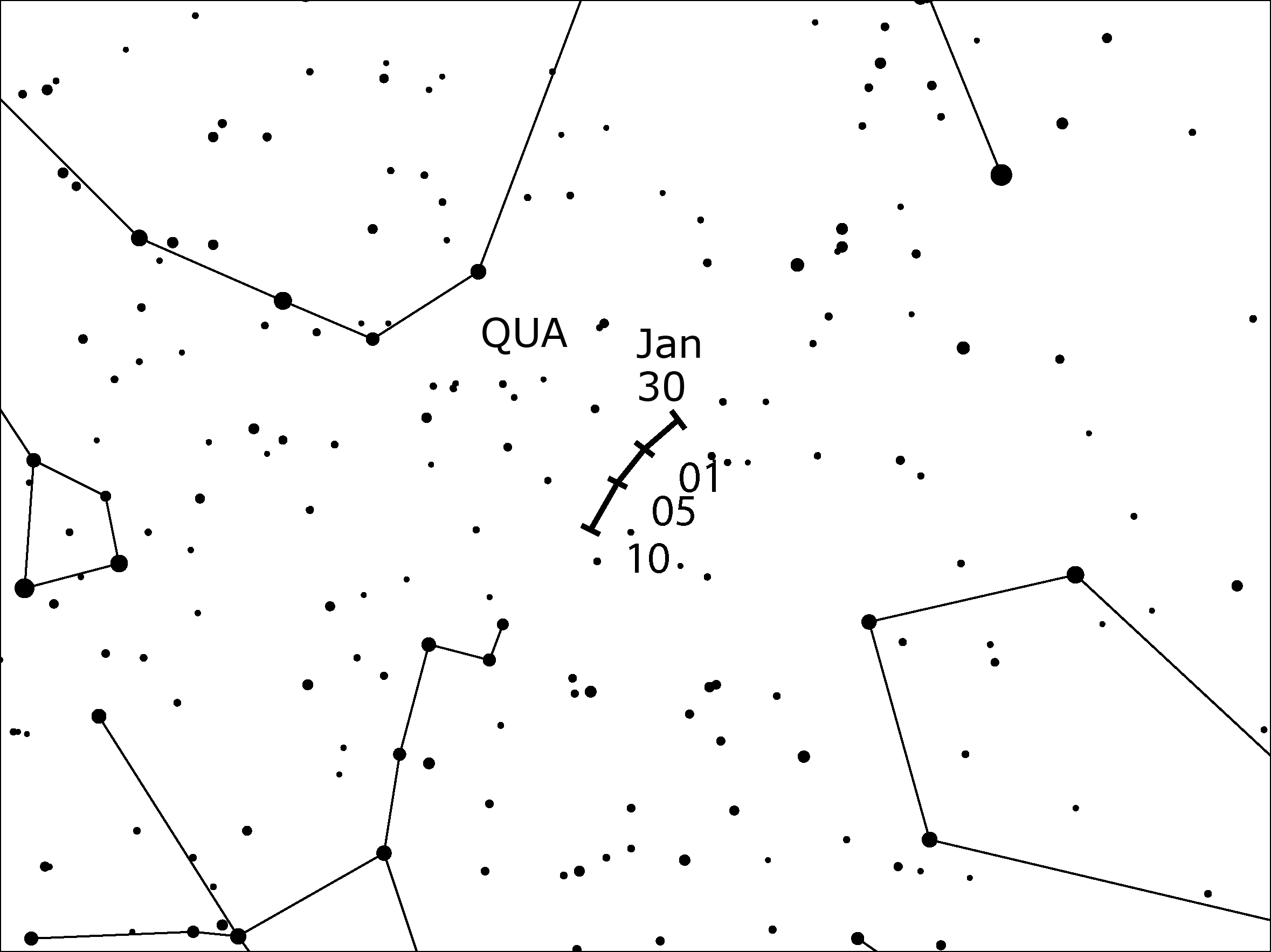
The new year offers the first interesting shower in the sky with the Quadrantids at the beginning of the month.
The Quadrantids reach their peak on January 3rd around 4 PM local time. At this time, possible observations are optimal during the second half of the night. Up to 80 meteors per hour can be observed, with variations between 60 and 200 meteors per hour recorded in the past. The activity extends until January 12th, with a higher frequency of brighter appearances observed in previous years in the days after the peak.
The Kappa Cancrids, which showed increased activity around January 10th in 2015, are active again this year. The radiant (Alpha=138°, Delta=9°) with the activity from 2015 reaches this position again on January 9th around 5 PM local time, however, the waxing moon affects possible observations. The shower meteors have a notably higher geocentric speed of approximately 47 kilometers per second than the meteors from the northeast Anthelion source.
The stream of the Gamma Ursa Minorids begins its short period of activity on January 10th. At the peak around January 18th, the rates under optimal conditions reach about three meteors per hour. This year, however, possible observations are strongly affected by moonlight. Some data regarding the meteor shower's activity remains uncertain.
In the area of the Anthelion source, shower meteors continue to be observed, but the rates are only slightly above the sporadic background. The Coma Berenicids, active since December, continue into February with low rates of about three meteors per hour.
December 2024
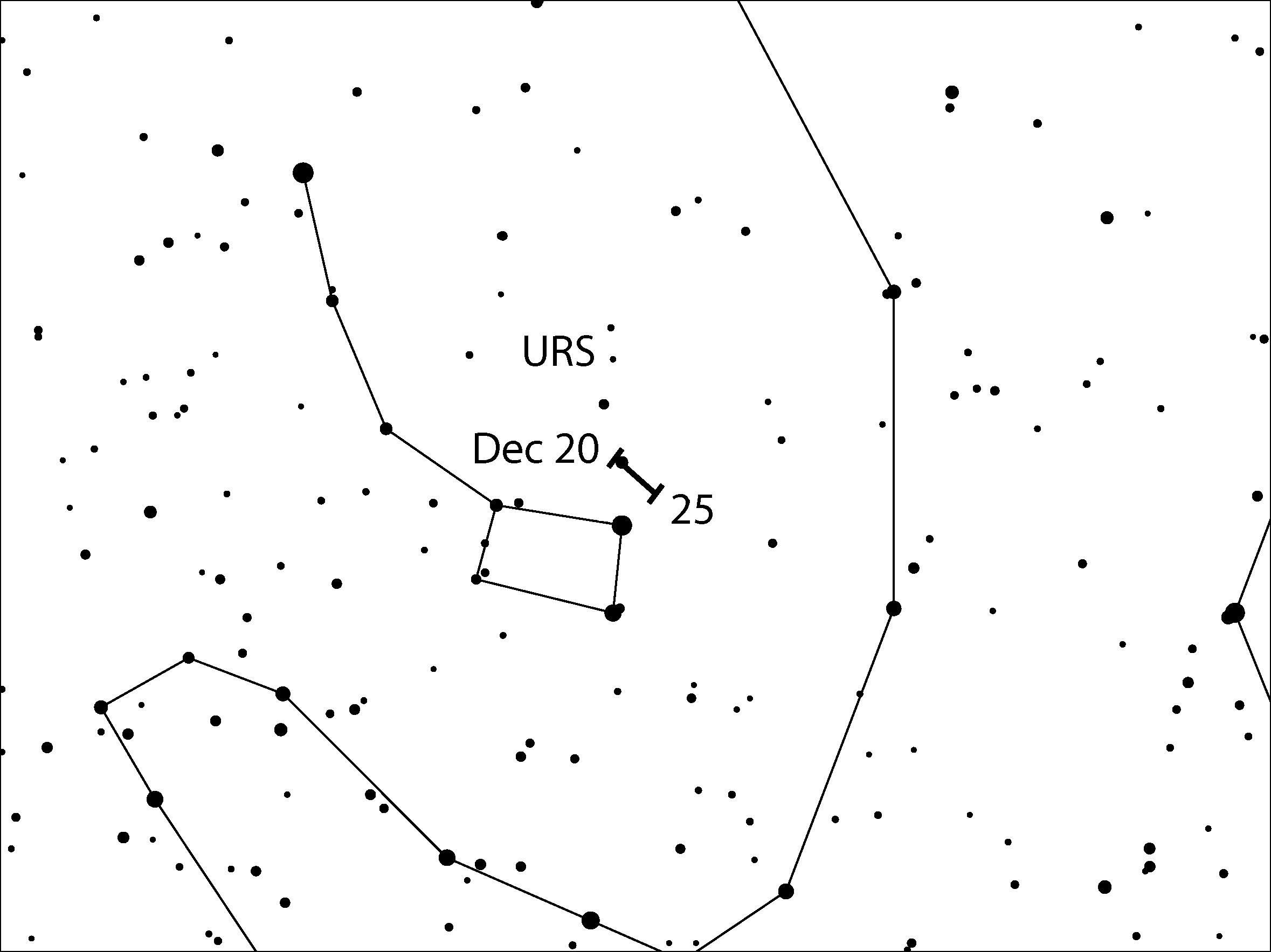
At the beginning of the month, the stream of the November Orionids is still active until December 6. Observations of the low activity are possible under optimal conditions (new moon on December 1).
For observations of the Andromedids, it is preferable this year to choose the second half of the night. The radiant is located in the sky at coordinates a = 29° and d = +47° near the star Gamma Andromedae. A possible maximum occurs on December 2. The last outburst was observed on November 28, 2021, and the activity is still very uncertain. However, data from past years indicate that a certain rate is observed annually.
The Geminids reach their maximum on December 14 around 02:00 local time. Then, under optimal conditions, hourly rates (zenithal hourly rates, ZHRs) of up to 150 meteors per hour are possible. This year, however, the maximum coincides with the full moon, so only brighter appearances will be recorded, and the rate is drastically reduced.
There is little data available from the Monocerotids stream. Its activity extends until December 20. The hourly rates are in the range of 2 to 3 meteors per hour. At the maximum on December 9, the second half of the night is moon-free.
The Yota Hydrids also reach their peak rate on December 9. The rates are in the range of the Monocerotids, but at maximum, hourly rates of five to eight meteors per hour are possible, and brighter appearances are not excluded. The second half of the night should also be chosen here.
On December 17, the Ursids begin their short activity until December 26. The waning moon disturbs the maximum on December 22 in the second half of the night, where the radiant reaches its highest altitude. Due to often unfavorable weather conditions, a possible higher activity has been missed. In the years 1945 and 1986, there were stronger outbursts in this stream.
At the end of the year, the first Quadrantids can already be observed. The radiant is circumpolar and particularly in the second half of the night has a sufficient height above the horizon.






